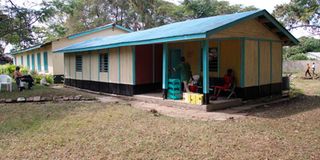Time’s up! Move GBV commitments from paper to action

A GBV recovery centre at Homa Bay County Teaching and Referral Hospital on November 23, 2021. The centre was established in December 2020, to support GBV survivors.
What you need to know:
- There is a significant dearth of shelters and safe houses where SGBV survivors can turn to for refuge and protection in their greatest time of need.
- Currently, Kenya has only one State-run shelter, established in in Makueni County in June 2020.
- The establishment of State-run SGBV shelters should be firmly embedded in law to guarantee sustainability.
At the 1995 Beijing Conference on Women, Kenya committed to take bold actions to promote gender equality and empowerment of women and girls. While there has been some progress 26 years on, much remains unchanged for women and girls, with many still experiencing multiple forms of violence.
Time has elapsed for the government to put legal teeth into its promises to protect women and girls from violence at home and in public spaces.
The Covid-19 pandemic and related restrictions have exacerbated the situation and shone a light on the severity of sexual and gender-based violence (SGBV), with some calling it the ‘shadow pandemic’.
Recent statistics showed a 71 per cent increase in reported cases of the vice between January and June 2020, compared to the previous year.
Earlier surveys showed that 45 per cent of women and girls aged above 15 years had experienced physical violence; and 14 per cent had experienced sexual violence, nationally. Recent high-profile examples such as the murder of Olympics record holder Agnes Tirop - who was allegedly stabbed to death by her husband - have amplified the urgency of the issue.
State-run shelter
Despite this, there is still a significant dearth of shelters and safe houses where SGBV survivors can turn to for refuge and protection in their greatest time of need. Most existing shelters are run by private individuals, faith-based and non-governmental organisations.
Currently, Kenya has only one State-run shelter, established in in Makueni County in June 2020.
A recent report by Human Rights Watch says the government failed to prevent GBV or ensure survivors access services during the Covid-19 pandemic. Increasing reports of widespread SGBV prompted President Uhuru Kenyatta to acknowledge that violence against women and girls was now a national crisis and declared it a matter of national urgency.
Shelters and safe houses are feeling the pinch. The Maisha Girls Safe House in Nairobi County has recorded a sharp rise in cases, and at one point hosted 52 women and girls despite being designed to accommodate only 24. Many other cases are turned away due to lack of space, while others go unreported.
There is also the thorny issue of funding. In December 2020, Nainyoie Safe House in Samburu County, was shut down due to lack of funds. This forced its residents - girls aged eight to 14 years, some survivors of female genital mutilation (FGM) and child marriage – to return home.
Lack of funds
Similarly, Woman’s Hope, another shelter in Nairobi County, has been forced to turn away at least three GBV survivors each day, due to lack of funds. This highlights the need for sustainable State funding for shelters at the county and national levels.
The recent pronouncement by the President to commit Sh2.3 billion for SGBV prevention and response by 2022, and Sh5 billion by 2026, is welcome. The government has also committed to scale up Policare centres (the National Police Service integrated response to SGBV).
More importantly, it has committed to establish State-run shelters in all the 47 counties. The President also stated that GBV mitigation strategies and support services would be integrated into the essential minimum package of Universal Health Care by 2022.
I commend the government for these commitments. However, as is evident from the 1995 Beijing Platform for Action, commitments are just words. And empty commitments cost lives.
The establishment of State-run SGBV shelters should be firmly embedded in law to guarantee sustainability. This is even more crucial given that there will soon be a change in the country’s administration as Kenya elects a new president in 2022. What will become of the SGBV-related commitments President Uhuru made, particularly those that outlive his presidency?
Legislative level
One way to ensure sustainable State funding for GBV shelters is to have a permanent line item in county and national budgets. It is heartening to note that some counties are having this conversation at the legislative level.
In Nairobi County, for example, there is a proposed bill - The Nairobi City County Sexual and Gender-Based Management and Control Bill. It is, however, yet to be signed into law. It proposes, amongst other measures, to establish shelters in at least one of the 17 sub-counties in the county and ensure budgetary allocation for the facilities.
Nonetheless, actions speak louder than words, and more needs to be done. To match the President’s pronouncements, we need to see more Members of County (and National) Assemblies advocating for gender-responsive budgets that facilitate a holistic response to GBV, including establishment and running of SGBV shelters.
As the world marks 16 Days of Activism against Gender-Based Violence, and with Kenya co-leading the GBV Action Coalition alongside other countries in the Generation Equality Forum, it’s only prudent that commitments move from paper to action, to ensure women’s rights and gender equality become a reality.




